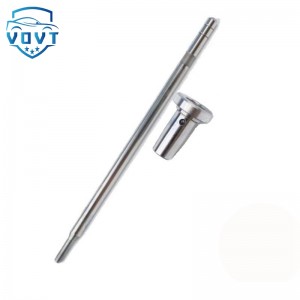High Precision New Diesel Injector Control Valve F00RJ01334 Valve Assembly for Fuel Injector Engine Spare Parts
Products Description
| Reference Codes | F00RJ01334 |
| Application | / |
| MOQ | 6 PCS |
| Certification | ISO9001 |
| Place of Origin | China |
| Packaging | Neutral packing |
| Quality Control | 100% tested before shipment |
| Lead time | 7~10 working days |
| Payment | T/T, L/C, Paypal, Western Union, MoneyGram or as your requirement |
Working mechanism of the injector valve assembly: precise control of the dynamic process of fuel injection
Abstract
The injector valve assembly is the core of the diesel engine electronic fuel system to achieve precise injection. Its performance directly determines the fuel atomization quality, injection timing and pressure stability. This article describes the structure, working mechanism, performance influencing factors and technical development trends of the valve assembly, and provides a reference for its design optimization and maintenance.
I. Structure and working mechanism
The injector valve assembly is mainly composed of a solenoid valve (or piezoelectric actuator), a valve needle, a valve seat, a reset spring and a seal. The solenoid valve receives the ECU pulse signal to generate electromagnetic force, overcomes the spring preload force to push the valve needle to open, and the high-pressure fuel is atomized and sprayed through the spray hole; after the signal is interrupted, the spring force resets the valve needle, and the sealing cone cuts off the oil circuit. The piezoelectric valve assembly has a faster response speed, and the valve needle is driven by crystal deformation, and the opening delay can be controlled within 0.1ms.
II. Performance influencing factors
The clearance between the valve needle and the valve seat (usually 0.001-0.003mm) is the key. Too large a clearance will cause leakage and make the injection amount deviation exceed 5%; too small a clearance will easily cause jamming. The roughness of the sealing cone surface must be below Ra0.02μm, otherwise the high-pressure fuel flushing will cause early wear. A 10% deviation in spring stiffness will cause the valve needle opening and closing pressure to fluctuate, affecting the consistency of injection. In addition, fuel impurities will aggravate the wear of the valve assembly, and high temperature will cause the thermal expansion of the material to change the matching accuracy.
III. Technology Development Trends
The use of tungsten carbide-based composite materials to improve the wear resistance of the valve needle and extend its life by more than 3 times; 3D printing technology is used to manufacture special-shaped flow channel valve seats to reduce fuel flow resistance by 15%. The intelligent valve assembly integrates micro sensors to monitor the displacement and pressure of the valve needle in real time, and dynamically compensates for the wear through the ECU to keep the injection accuracy within ±1%. These innovations have enabled the injector to improve fuel efficiency by 8% while meeting the National VII emission standards.

























